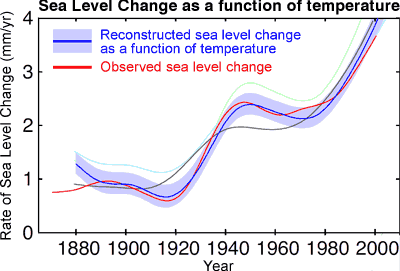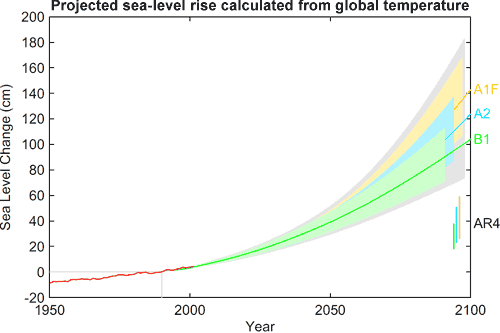Predicting future sea level rise
Posted on 18 December 2009 by John Cook
The two main contributors to sea level rise are thermal expansion of water and melting ice. Predicting the future contribution from melting ice is problematic. Most sea level rise from ice melt actually comes from chunks of ice breaking off into the ocean, then melting. This calving process is accelerated by warming but the dynamic processes are not strongly understood. For this reason, the IPCC didn't include the effects of dynamic processes, arguing they couldn't be modelled. In 2001, the IPCC Third Assessment Report (TAR) projected a sea level rise of 20 to 70 cm by 2100. In 2007, the IPCC Fourth Assessment Report (4AR) gave similar results, projecting sea level rise of 18 to 59 cm by 2100. How do the IPCC predictions compare to observations made since the two reports?

Figure 1: Sea level change. Tide gauge data are indicated in red and satellite data in blue. The grey band shows the projections of the IPCC Third Assessment report (Allison et al 2009).
Observed sea level rise is tracking at the upper range of model predictions. Why do climate models underestimate sea level rise? The main reason for the discrepancy is, no surprise, the effects of rapid flow ice changes. Ice loss from Greenland, Antarctica and glaciers are accelerating. Even East Antarctica, previously considered stable and too cold, is now losing mass. Considering the importance of rising sea level to a human population crowded around coastlines, how can we predict sea level with greater accuracy?
An alternative way to predict future sea level rise is a semi-empirical method that uses the relationship between sea level and global temperature (Vermeer 2009). Instead of modelling glacier dynamics, the method uses model projections of global temperature which can be calculated with greater confidence. Sea level change is then derived as a function of temperature change. To confirm the relationship between sea level and temperature, observed sea level was compared to reconstructed sea level calculated from global temperature observations from 1880 to 2000. Figure 2 shows the strong correlation between observed sea level (red line) and reconstructed sea level (dark blue line with light blue uncertainty range).

Figure 2: Observed rate of sea-level rise (red) compared with reconstructed sea level calculated from global temperature (dark blue with light blue uncertainty range). Grey line is reconstructed sea level from an earlier, simpler relationship between sea level and temperature (Vermeer 2009).
The historical record shows the robustness of the relationship between sea level and global temperature. Thus, global temperature projections can be used to simulate sea levels into the future. A number of different emission scenarios were used, based on how carbon dioxide emissions might evolve over the next century. Overall, the range of projected sea level rise by 2100 is 75 to 190 cm. As you get closer to 2100, the contribution from ice melt grows relative to thermal expansion. This is the main difference to the IPCC predictions which assume the portion of ice melt would diminish while thermal expansion contributes most of the sea level rise over the 21st Century.

Figure 3: Projection of sea-level rise from 1990 to 2100, based on IPCC temperature projections for three different emission scenarios. The sea-level range projected in the IPCC AR4 for these scenarios are shown for comparison in the bars on the bottom right. Also shown in red is observed sea-level (Vermeer 2009).
Figure 3 shows projected sea level rise for three different emission scenarios. The semi-empirical method predicts sea level rise roughly 3 times greater than the IPCC predictions. Note the IPCC predictions are shown as vertical bars in the bottom right. For the lowest emission rate, sea levels are expected to rise around 1 metre by 2100. For the higher emission scenario, which is where we're currently tracking, sea level rise by 2100 is around 1.4 metres.
There are limitations to this approach. The temperature record over the past 120 years doesn't include large, highly non-linear events such as the collapse of an ice sheet. Therefore, the semi-empirical method can't rule out sharp increases in sea level from such an event.
Independent confirmation of the semi-empirical method is found in a kinematic study of glacier movements (Pfeffer 2008). The study examines calving glaciers in Greenland, determining each glacier's potential to discharge ice based on factors such as topography, cross-sectional area and whether the bedrock is based below sea level. A similar analysis is also made of West Antarctic glaciers (I can't find any mention of calculating ice loss from East Antarctica). The kinematic method estimates sea level rise between 80 cm to 2 metres by 2100.
Recent observations find sea level tracking at the upper range of IPCC projections. The semi-empirical and kinematic methods provide independent confirmation that the IPCC underestimate sea level rise by around a factor of 3. There are growing indications that sea level rise by the end of this century will approach or exceed 1 metre.
UPDATE 18/12/2009: A new paper has just come out looking at sea levels during the last interglacial around 120,000 years ago (Kopp 2009). Polar temperatures were around 3 to 5 degrees hotter than now, which is the amount of warming expected for some of the lower emission scenarios. Sea levels at that time were between 6 to 9 metres higher than today. This is not to say sea levels will reach these levels by 2100 - it would take longer for the climate to reach equilibrium. What it does show is that ice sheets are vulnerable to sustained warming.
In a future post, I will look at impacts of rising sea levels. If anyone can suggest recent peer reviewed papers on this area, particularly on a global scale, it would save me a lot of leg work and be very deeply appreciated (Chris, I'm looking at you). Links to full PDFs earn you an extra gold star.
Also, many thanks to Charles Fletcher whose advice and suggestions are an immense help. His paper Sea Level by the end of the 21st Century: A Review was the original inspiration for this post.































 Arguments
Arguments






























Pfeffer 2008 is freely available online (you can register on Science for a free account) so I leave this one as an exercise for the reader :-)
1. Temperature has changed naturally in the past (before humans).
2. As sea level is directly affected by sea level (as established in Vermeer 2009) then sea level has changed naturally in the past
Do not fall into the logical fallacy that past natural climate change means humans can't influence climate now. On the contrary, past climate change shows us that climate is sensitive to radiative forcing - to energy imbalance. As we are currently imposing an energy imbalance through an enhanced greenhouse effect, past climate change is actually evidence for our climate's sensitivity to CO2.
Is it likely that cyclical ice ages will occur in the future? In the short term (geologically speaking), the peer reviewed science says no. The radiative forcing from CO2 far outstrips the radiative forcing from orbital changes that initiate cyclical ice-ages. I touch on this tangentially on We're heading into a new Little Ice Age although that page is talking more about the forcing from falling solar levels, not orbital forcing. However, orbital forcing is even less than solar forcing so the argument stands (one of these days I'll do a post specifically focusing on Milankovitch cycles).